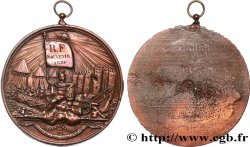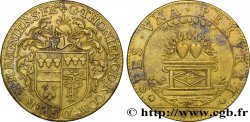fme_1019358 - III REPUBLIC Médaille, Rosière de la Brède
150.00 €(Approx. 172.50$ | 132.00£)
Quantity
Add to your cart

Type : Médaille, Rosière de la Brède
Date: 1885
Metal : silver
Diameter : 61 mm
Orientation dies : 12 h.
Engraver VAUTHIER-GALLÉ André (1818-1899)
Weight : 53,763 g.
Edge : lisse + corne ARGENT
Puncheon : corne ARGENT
Coments on the condition:
Patine hétérogène avec des traces d’usure, fortement et quelques coups. Beau brillant de frappe
Catalogue references :
Obverse
Obverse legend : REPUBLIQUE - * FRANCAISE.
Obverse description : Tête féminine de profil à gauche, coiffée d’une couronne de feuilles d’olivier, chêne et épis de blé, grappe de raisin. Signé : VAUTHIER GALLE F..
Reverse
Reverse legend : THERESE MARGUERITE CHABAUDET - * 29 JUIN 1885 // AGEE DE 18 ANS / ROSIERE / DE LA BREDE.
Reverse description : Légende en 5 lignes dans une couronne de laurier.
Commentary
Médaille décernée à Thérèse Marguerite Chabaudet en 1885 avec un diamètre sans bélière de 45,5 mm.
La fête de la Rosière a été instaurée par François de Paule Latapie pour rendre hommage à l’illustre philosophe brédois : Montesquieu. Elle met à l’honneur une jeune fille de 18 ans, élue par ses pairs, mais aussi son rosier et ses anciens camarades de classe qui forment le cortège. Pendant 3 jours de festivité, cet événement emblématique rassemble toutes les générations.
Medal awarded to Thérèse Marguerite Chabaudet in 1885 with a diameter of 45.5 mm without bail. The Fête de la Rosière was established by François de Paule Latapie to pay tribute to the illustrious philosopher from Bréd: Montesquieu. It honors an 18-year-old girl, elected by her peers, but also her rosebush and her former classmates who form the procession. During 3 days of festivities, this emblematic event brings together all generations
La fête de la Rosière a été instaurée par François de Paule Latapie pour rendre hommage à l’illustre philosophe brédois : Montesquieu. Elle met à l’honneur une jeune fille de 18 ans, élue par ses pairs, mais aussi son rosier et ses anciens camarades de classe qui forment le cortège. Pendant 3 jours de festivité, cet événement emblématique rassemble toutes les générations.
Medal awarded to Thérèse Marguerite Chabaudet in 1885 with a diameter of 45.5 mm without bail. The Fête de la Rosière was established by François de Paule Latapie to pay tribute to the illustrious philosopher from Bréd: Montesquieu. It honors an 18-year-old girl, elected by her peers, but also her rosebush and her former classmates who form the procession. During 3 days of festivities, this emblematic event brings together all generations








 Report a mistake
Report a mistake Print the page
Print the page Share my selection
Share my selection Ask a question
Ask a question Consign / sell
Consign / sell
 Full data
Full data














